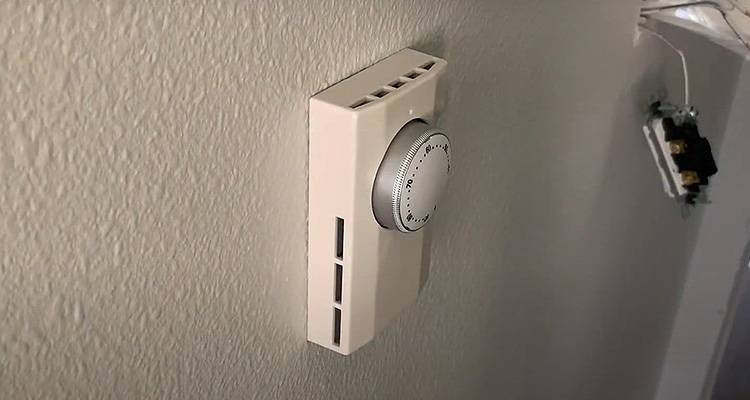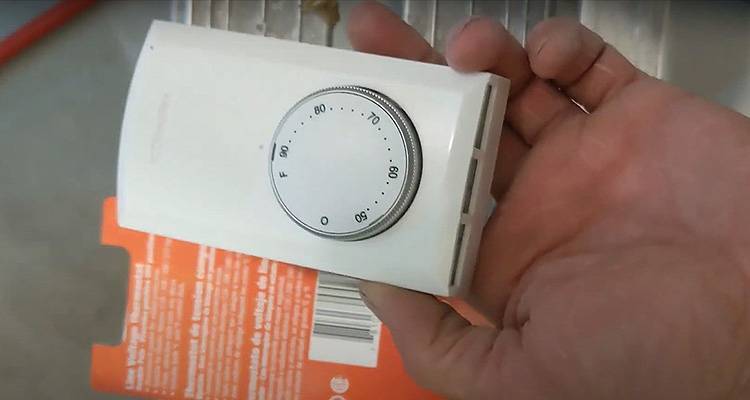
When it comes to controlling the temperature in your home, thermostats play a crucial role. However, not all thermostats are created equal, and there are significant differences between single vs double-pole thermostat. Comprehending these distinctions is crucial for homeowners seeking to make well-informed choices regarding their heating and cooling systems.
This article will investigate an in-depth comparison of single-pole and double-pole thermostats, exploring their functions, benefits, and drawbacks. By the end, homeowners will be equipped with the knowledge to choose the right thermostat for their specific needs, ensuring optimal comfort and energy efficiency.
Understanding Thermostats
A thermostat is a device employed for controlling the temperature of a system. It is commonly found in heating, ventilation, and air conditioning (HVAC) systems and in household appliances like refrigerators and ovens.
The basic principle behind a thermostat is that it senses the current temperature and then activates or deactivates the heating or cooling system to maintain a desired temperature. This is achieved using a sensor to measure the temperature and a control unit to compare it with the set temperature.
Suppose the current temperature deviates from the desired one. In that case, the control unit signals the heating or cooling system to turn on or off. A thermostat is crucial in maintaining comfortable and optimal temperatures in various systems.
Read Our Most Populer Article : What to Put Under Toaster Oven to Protect Counter? How to Clean Tea Stains from Stainless Steel Travel Mug Why is My Portable Ice Maker Not Making Ice Nebulizer vs Humidifier Reviews How To Use a Food Scale, Digital Kitchen Scale For Weight Loss

Single Pole Thermostat
Overview of Single Pole Thermostat
Single-pole thermostats are commonly used in residential heating and cooling systems. They are designed to control the operation of heating or cooling equipment by sensing the temperature in a room or a specific area. These thermostats are simple and easy to install, making them popular among homeowners.
Single-pole thermostats typically have a simple dial or lever for adjusting the temperature setting. Once the room temperature matches the designated set point, the thermostat will automatically deactivate the heating or cooling apparatus.
However, suppose the temperature drops below the set point. In that case, the thermostat will turn the equipment back on to maintain the desired temperature. Overall, single-pole thermostats provide a basic and reliable way to regulate temperature in residential settings.
How Single Pole Thermostats Work
Single-pole thermostats are a simple and commonly used mechanism for controlling home and building temperature. These thermostats utilize a bimetallic strip that expands or contracts with temperature changes.
A mercury switch or a similar device is connected to the bimetallic strip inside the thermostat. When the temperature rises above the set point, the bimetallic strip expands, and the switch is tipped the other way, turning off the heating or cooling system.
The bimetallic strip contracts as the temperature drops below the set point, causing the switch to tip back and turn the system on again. This continuous process helps to maintain a consistent temperature in the space.
Benefits and Limitations of Single Pole Thermostat
Single-pole thermostats offer several benefits for controlling the temperature in residential and commercial buildings.
Firstly, they are simple and easy to operate, allowing users to adjust the temperature with minimal effort. Moreover, single-pole thermostats are cost-effective and widely accessible, contributing to their popularity among budget-conscious individuals. They also consume less energy than other types of thermostats, resulting in cost savings on utility bills.
However, these thermostats have some limitations. Firstly, they can only control one heating or cooling device at a time, which might be a drawback in larger buildings with multiple zones. Furthermore, they lack advanced features like programmability and remote control, restricting the flexibility and convenience of temperature regulation.

Double Pole Thermostat
Overview of Double Pole Thermostat
Double-pole thermostats are commonly used in residential and commercial buildings to control heating and cooling systems. These thermostats have two independent switch contacts that open and close simultaneously.
This means that the thermostat controls both the heating and cooling circuits. When the temperature drops below the set point, the contacts close, and the heating system is activated. On the other hand, when the temperature rises above the set point, the contacts open, and the cooling system is activated.
This thermostat provides more flexibility in controlling temperature and ensures efficient operation of HVAC systems. Additionally, it offers increased safety by cutting off the heating and cooling circuits in case of any malfunction or overheating.
How Double Pole Thermostats Work
Double-pole thermostats are an essential component of heating and cooling systems. Unlike single-pole thermostats, which control only one electrical circuit, double-pole thermostats can control two separate circuits simultaneously.
This is achieved through two separate sets of contacts that open and close based on the desired temperature settings. When the temperature rises above the set point, the contacts close and complete an electrical circuit, activating the heating or cooling system.
Conversely, when the temperature drops below the set point, the contacts open, interrupting the power supply to the system. This dual circuit control ensures precise temperature regulation and efficient operation of the HVAC system.
Benefits and Limitations of Double Pole Thermostat
Double pole thermostats offer several benefits in controlling heating and cooling systems. One major advantage is their ability to completely disconnect power when the desired temperature is reached, ensuring energy efficiency and preventing unnecessary heat or cooling loss.
Additionally, double-pole thermostats provide a higher level of safety by completely cutting off the power supply, reducing the risk of electrical malfunctions or fires. However, there are limitations to consider.
Double-pole thermostats can be more expensive than single-pole thermostats, making them less accessible for budget-conscious consumers. In addition, the installation process may necessitate professional help due to the intricate wiring involved.
Read Our Recent Article : How to Make a Refrigerator Flush with Cabinets How to Reset Filter Light on Samsung Refrigerator How to Clean Samsung Refrigerator How to Use Newco Coffee Maker Ninja vs. Oster Blender
What’s The Differences Between Single Pole and Double Pole Thermostat
Wiring and Connections
Single-pole and double-pole thermostats differ in their wiring and connection requirements. The main distinction lies in the number of wires needed for installation. A single pole thermostat typically requires only two wires, as it interrupts the flow of electricity to the heating or cooling device.
On the other hand, a double pole thermostat requires four wires as it controls both the electric power supply and the neutral wire. This makes it suitable for high-voltage systems or where dual power sources are necessary. Additionally, the wiring configuration for double pole thermostats is often more complex, as it involves connections to both the hot and neutral lines.
Overall, understanding these differences is crucial for properly installing and functioning thermostats in HVAC systems.
Compatibility with Baseboard Heaters
Single-pole and double-pole thermostats are compatible with baseboard heaters but differ in their wiring requirements. Single-pole thermostats are the most common and use a simple two-wire connection. They control the power to the heating element by interrupting one side of the circuit.
On the other hand, double-pole thermostats require a four-wire connection and control the power to both sides of the heating element simultaneously. This allows for better temperature control and prevents the risk of electric shock.
When choosing between the two, consider the wiring in your home and the desired level of temperature control.
Line Voltage vs Low Voltage
Single-pole and double-pole thermostats are used in different systems, specifically line-voltage and low-voltage systems. Line voltage thermostats are typically used in high-voltage systems such as electric baseboard heaters, wall heaters, and radiant ceiling panels.
These thermostats control the voltage supply by interrupting or connecting the line to the load. On the other hand, low-voltage thermostats are commonly used in HVAC systems and control the temperature by opening or closing a low-voltage circuit.
They are usually connected to a control board or transformer, which allows them to operate at a lower voltage than the power supply. In summary, the main difference between single-pole and double-pole thermostats lies in the voltage they control and the systems they are designed for.
Control of Heating Elements
Single-pole and double-pole thermostats are two commonly used types of controls for heating elements. The main difference between these two is the number of poles or switches. A single-pole thermostat has only one switch, which means it can control only one heating element at a time.
On the other hand, a double-pole thermostat has two switches, allowing it to control two heating elements simultaneously. This means a double pole thermostat can handle more power load and control larger heating systems. Additionally, double-pole thermostats provide better safety features as they completely disconnect the hot and neutral wires when the heating system is turned off.
Overall, the choice between a single-pole and double-pole thermostat depends on the size and complexity of the heating system.
Energy Efficiency
Single-pole and double-pole thermostats differ in terms of their energy efficiency. Single-pole thermostats control the operation of only one pole of the heating system, which means they only cut off the power supply to the heater.
This can result in energy wastage as the heating system may continue to draw small amounts of power even when not required. On the other hand, double-pole thermostats control both poles of the heating system, completely cutting off the power supply when the desired temperature is achieved.
This ensures maximum energy efficiency as there is no power wastage during idle periods. Therefore, double-pole thermostats are considered to be more energy-efficient than single-pole thermostats.
Which Thermostat is Right for You?
Choosing the right thermostat for your home depends on your needs and preferences. Suppose you are tech-savvy and enjoy controlling your home’s temperature from anywhere. A smart thermostat may be your best option.
You can control smart thermostats using smartphones or voice-activated devices like Google Home or Amazon Echo. They also have features like learning algorithms that can adapt to your schedule and preferences, saving you energy and money.
On the other hand, if you prefer a simple thermostat, a programmable one might be more suitable. With programmable thermostats, you can establish precise temperature schedules for various times of the day and week, affording you the versatility to conserve energy during your absence and sustain a pleasant temperature at home.
Summary of Key Differences
A single-pole thermostat is a device that can interrupt only one leg of the electrical circuit. In contrast, a double-pole thermostat can interrupt both legs of the circuit. This means a single-pole thermostat may still have some electrical current flowing even when turned off.
In contrast, a double-pole thermostat disconnects all power when it is in the off position. The key difference lies in the level of safety and control offered by each type of thermostat. A double pole thermostat provides a higher level of safety, as it completely cuts off the power supply, ensuring no electrical current flows.
It is often used in high-voltage applications, such as HVAC systems, where safety is paramount. Conversely, a single-pole thermostat is more commonly used in low-voltage applications. It may require additional safety measures to mitigate any residual current.
Final Thoughts: Single Pole And Double Pole Thermostat
The main difference between a single-pole and a double-pole thermostat is the number of contacts. A single-pole thermostat has only one contact, which can break the connection to just one side of the circuit.
On the other hand, a double-pole thermostat has two contacts, allowing it to break the connection to both sides of the circuit simultaneously. This makes the double pole thermostat more reliable and safer, as it shuts off the electrical supply when needed.
Moreover, electrical codes often require a double-pole thermostat for applications like electric baseboard heaters. Ultimately, the choice between the two types depends on the heating system’s specific requirements and safety considerations.
FAQ’s about Single Pole vs Double Pole Thermostat
The type of thermostat you should use depends on the type of heater you have and the electrical requirements. Single-pole thermostats are commonly used with 120V line-voltage heaters, while double-pole thermostats are used with 240V line-voltage heaters.
Wiring a single-pole thermostat is relatively simple. Typically, one wire from the power line is connected to one terminal of the thermostat, and another wire from the heater is connected to the other terminal. It is recommended to consult the manufacturer’s installation instructions or hire a professional electrician if you need clarification.
It is possible to replace a single-pole thermostat with a double-pole thermostat if the heater and electrical system can support the higher voltage requirements. However, it is recommended to consult a professional electrician to ensure proper installation and compatibility.
When installing or replacing line-voltage thermostats, it is important to ensure that the power to the heater is turned off at the circuit breaker or electrical panel. This helps prevent any electrical shocks or accidents during the installation process.
Leave a Reply